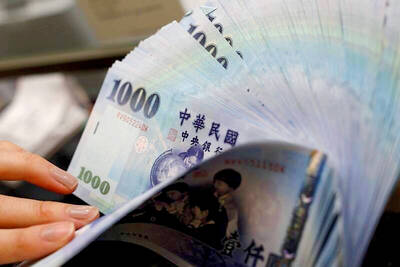Ask Liu Chun-ting (劉軍廷) about future growth engines for his company, LCD maker AU Optronics Corp (友達光電), and he whips out his Kindle e-book in lieu of an answer.
Strong reception for the Kindle, the brainchild of Web retailer Amazon, is attracting a growing number of developers looking to tap interest in devices that let consumers read newspapers, magazines and books in a digital form that updates wirelessly and saves paper.
Sony Corp has joined the paperless wave with its own e-readers, partnering with Google to offer public domain books that are no longer protected by copyright.
Other believers in the dawn of a paperless age include Taiwan’s Netronix Inc (振曜科技), which is making similar models with touchscreens, and Dutch Polymer Vision, set to soon introduce a pocket e-reader with rollable displays.
“We see it as a new industry,” said Liu, a senior vice president at AU Optronics, the world’s No.3 LCD maker whose panels are part of Dell, Hewlett-Packard and Apple PCs, as well as Sony LCD TVs.
“It replaces paper, printing, publishing, text books, and so on,” said Liu, who is in charge of AU Optronics’ consumer display business.
MUST-HAVES
The growing number of models could help to bring down prices and boost sales, making these portable readers the next breed of must-have gadgets.
Weighing less than a typical paperback, e-books use a new generation of light, flexible and interactive display, or e-paper. Once the power is off, its images remain unchanged on the screen as it needs no added light source to read.
Because they require no backlighting like traditional LCDs, e-books consume far less power and are also much lighter. A typical Kindle can be read for days without recharging.
STRUGGLING
The bright future of e-books is particularly attractive to major LCD makers in Asia, including AU Optronics and hometown rival Chi Mei Optoelectronics Corp (奇美電子), at a time when they are struggling with sluggish sales of PCs and flat-screen TVs.
AU Optronics, which booked a record loss in the October-December quarter, is branching out to the new display sector by buying a 21 percent stake in e-paper specialist SiPix Imaging Inc.
Amazon.com Inc’s Kindles have proved a hit since their launch in 2007. Citigroup estimated the US online retailer sold a half-million Kindles last year, about one-third more than the number of iPods sold by Apple in its first year.
Some critics argue that e-books could become the victim of their own success if cellphone makers take notice and start to incorporate the newer LCD technology into their own models and include similar reading applications.
Other kinds of devices could also try to incorporate e-book-like applications.
“There will be more low-cost digital reading platforms coming out. Netbook PCs, for example, are much cheaper,” said Jeremy Huang, who tracks the e-book market for the Market Intelligence & Consulting Institute (MIC, 產業情報研究所), a private industry researcher in Taiwan.
Netbooks, low-cost mini-notebook computers, sell for as little as US$299, while a Kindle retails for US$359 and the latest model of the Sony Reader is priced at about US$349.
Market research firm iSuppli Corp forecasts global e-book display revenue will rise to US$291 million by 2012, representing an annual growth rate of 143 percent from 2007. That is still much smaller than about US$72 billion for large LCDs last year.
SUBSIDIZE
To help drive the e-reader market, some analysts say book publishers could subsidize a low-cost e-reader, or even give one away, with a multi-year subscription, similar to how telecom operators subsidize cellphones in return for service contracts.
The use of e-paper displays in other devices, such as signs, could also help to build economies of scale, bringing down costs.
Supporters imagine a day when e-paper versions of portable newspaper and magazine readers might be rolled up or folded, and carried to the beach or read on the train by commuters.
The timing of e-readers seems particularly good as the ink-stained newspaper market is struggling and some papers are cutting their print editions because of the recession and as more people go online to get news for free.
STRATEGIC DEALS
In February, US-based Plastic Logic signed strategic deals with media partners, including the Financial Times, USA Today and Zinio, for its first e-readers to target business users.
The devices boast a large display and weigh less than many printed magazines.
In South Korea, LG Display Co has been developing A4-size color flexible e-paper among other potential products for the e-reader market.
“Screens will replace papers, that’s given. But I doubt whether e-books will make a sizeable market in the next two years,” said Park Hyun, an analyst at Prudential Investment & Securities.
“They are preparing for the new business, but it won’t mean much for their business or earnings until the market grows in size,” Park said.

Merida Industry Co (美利達) has seen signs of recovery in the US and European markets this year, as customers are gradually depleting their inventories, the bicycle maker told shareholders yesterday. Given robust growth in new orders at its Taiwanese factory, coupled with its subsidiaries’ improving performance, Merida said it remains confident about the bicycle market’s prospects and expects steady growth in its core business this year. CAUTION ON CHINA However, the company must handle the Chinese market with great caution, as sales of road bikes there have declined significantly, affecting its revenue and profitability, Merida said in a statement, adding that it would

MARKET LEADERSHIP: Investors are flocking to Nvidia, drawn by the company’s long-term fundamntals, dominant position in the AI sector, and pricing and margin power Two years after Nvidia Corp made history by becoming the first chipmaker to achieve a US$1 trillion market capitalization, an even more remarkable milestone is within its grasp: becoming the first company to reach US$4 trillion. After the emergence of China’s DeepSeek (深度求索) sent the stock plunging earlier this year and stoked concerns that outlays on artificial intelligence (AI) infrastructure were set to slow, Nvidia shares have rallied back to a record. The company’s biggest customers remain full steam ahead on spending, much of which is flowing to its computing systems. Microsoft Corp, Meta Platforms Inc, Amazon.com Inc and Alphabet Inc are

RISING: Strong exports, and life insurance companies’ efforts to manage currency risks indicates the NT dollar would eventually pass the 29 level, an expert said The New Taiwan dollar yesterday rallied to its strongest in three years amid inflows to the nation’s stock market and broad-based weakness in the US dollar. Exporter sales of the US currency and a repatriation of funds from local asset managers also played a role, said two traders, who asked not to be identified as they were not authorized to speak publicly. State-owned banks were seen buying the greenback yesterday, but only at a moderate scale, the traders said. The local currency gained 0.77 percent, outperforming almost all of its Asian peers, to close at NT$29.165 per US dollar in Taipei trading yesterday. The

The US overtaking China as Taiwan’s top export destination could boost industrial development and wage growth, given the US is a high-income economy, an economist said yesterday. However, Taiwan still needs to diversify its export markets due to the unpredictability of US President Donald Trump’s administration, said Chiou Jiunn-rong (邱俊榮), an economics professor at National Central University. Taiwan’s exports soared to a record US$51.74 billion last month, driven by strong demand for artificial intelligence (AI) products and continued orders, with information and communication technology (ICT) and audio/video products leading all sectors. The US reclaimed its position as Taiwan’s top export market, accounting for